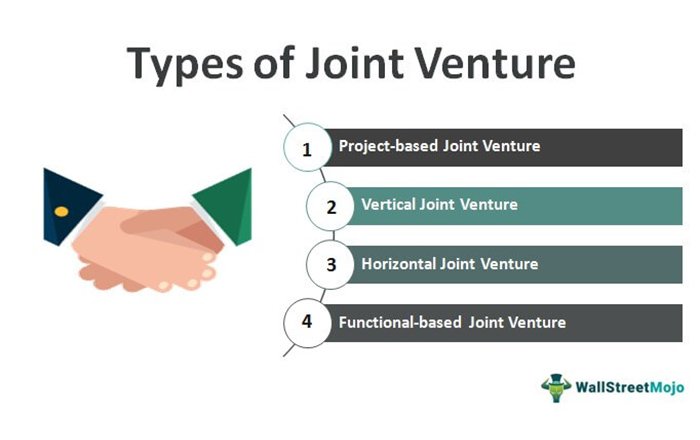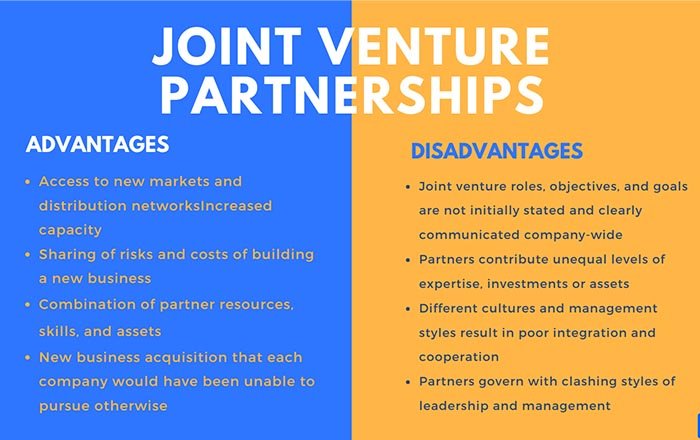Joint Ventures (JVs): Definition and Reasons of Collaborative Partnerships
Joint ventures (JVs) have become an increasingly popular and lucrative way to grow businesses in today’s global economy. They provide access to new skills, markets, resources, capital, and distribution networks.
By combining the strengths of two or more parties, JVs can achieve greater success than any individual entity would be able to do alone. Through close collaboration and resource pooling these partnerships can create a competitive advantage that results in long-term value for all participants.
While pursuing joint venture opportunities may look attractive from the outset, potential partners must take into consideration strategic planning and conduct due diligence to ensure a successful partnership.
Contents
What is Joint Ventures?

Source
A joint venture (JV) is a commercial agreement between two or more parties to share ownership and control of an undertaking while pooling resources, knowledge, and obligations.
Unlike partnerships or corporations, a JV manifests itself in the form of a distinct legal entity that operates with its own management structure and metrics to ensure that all assets are managed jointly and efficiently.
It can also have different features depending on which type of JV has been formed such as equity or contractual-based.
Key features of JVs
Joint Ventures (JVs) involve collaboration between two or more businesses in order to combine their resources and expertise. Shared ownership and control are essential components of any JV agreement–no matter how much or little equity each partner can bring to the table.
These arrangements define two partners’ cumulative rights and liabilities, allowing them to work together toward a collective goal while shouldering related costs together instead of acting independently.
As such, legal documentation detailing the extent of each part+ner’s ownership, duties as shareholders, or liquidity rights, is common. JVs carry the additional benefit of mitigated risk for both parties as liabilities and losses will likely not be shouldered to the same extent if a partner opted to go alone.
2. Collaboration and resource pooling
Joint ventures are based on a shared vision and collaboration between two or more partner organizations.
For resource pooling to be effective in JVs, partners must identify compatible needs and find ways to analyze risks as well as maximize successful aspects of their resources.
Pooled resources create the capacity necessary for increased scale or better quality; they also potentially reduce the overall operational cost.
Beyond financial considerations, it is important for each partner organization within resource pooling collaborations to cultivate trust and strengthen understanding as activities grow.
3. Legal structure and agreements
Joint ventures legally require a structure with specific agreements in order to legalize the partnership. Legal documents are also necessary in order to limit liabilities, regulate asset and ownership division and name individual roles of the venture.
The most important documentation for any JV is an affiliation agreement that outlines operational procedures which include rights and obligations of both parties, duties of management, decision-making protocols, dispute resolution mechanisms as well as exit protocols should one partner be required or decide to leave the association.
Additionally, there may be some tax considerations and contractual rights of other interrelated agreements that need to be factored into the legal structure and agreement such as trademark agreements or technology redistribution.
All in all, building a strong legal base from filing certain certificates with the government to intricate negotiations is an important part of any joint venture business reference binding both partners into specified arrangements.
Types of Joint Ventures

Equity-based JVs
1. Equal equity partnerships
Equal equity partnerships are a type of Equity-based JV in which two or more parties have equal ownership and control. These joint ventures must enter into formal agreements that prioritize the sharing of management, cost, risk, capital, and profits.
In the agreement, both parties consider responsibility for running operations as well as offering up complements to each party’s sets of skills. Participating businesses benefit from geographic expansion opportunities while leveraging their resources together to bring forth innovative advantages from other business cultures.
Because all decisions and performance indicators are ultimately joint between the participants, equal access to information transparency as well as decision-making processes continued commitment from both parties for successful business operations.
2. Majority-minority partnerships
Majority-minority partnerships are a type of joint venture structure wherein two companies come together to form an entity with ownership based on proportions other than equal shares.
In these arrangements, one company typically has control over the business while the other enjoys a minority share, usually including rights for representation in matters related to decision-making.
This kind of setup allows larger companies to retain clout and leadership even when collaborating with another company, while non-dominant parties can take advantage of opportunities that would otherwise be more inaccessible.
Businesses creating majority-minority partnerships often involve strategic counterparts—those which will benefit the partnering firm in terms of market intelligence, global networking, and other imperative resources.
3. Non-equal equity partnerships
Non-equal equity partnerships, also known as Consortia joint ventures, involve partners contributing varying amounts of initial cash or other assets to the venture rather than sharing ownership evenly.
This structure allows each participant to retain control over the portion of the new business that it has funded and allows them to protect their own strategic interests.
Non-equal equity structures enable combining larger strategic partners with smaller technical experts or rural production facilities into the same venture in order to create unique capabilities;
That would otherwise be out of reach for the cooperating parties involved occasionally compensating or rewarding stakeholders not only based on the financial returns achieved from each joint venture but also considering other individual benefits obtained by way of participating.
Contractual JVs
1. Cooperation agreements
Cooperation agreements involve the exchange of specific business services or technology to create economic benefits. A common form of a contractual joint venture, cooperation agreements can come in the form of strategic alliances and marketing consortiums, among others.
Typically negotiated and established together for mutual gain, both corporate entities collaborate without exchanging risks or forming a new legal entity.
Careful coordination of execution must take place, with well-defined performance objectives and regulations for breach in case either side defaults on its obligations. Negotiations may involve strategically limiting both companies’ liabilities to protect IP and other assets as well.
Cooperation agreements will prove more successful if each side maintains transactional transparency throughout the collaboration process.
2. Licensing agreements
Contractual joint ventures are some of the most common JV structures, and within this form, licensing agreements are one of the most widely used. Licensing agreements establish a contractual partnership between two parties for permission to use another party’s intellectual property rights such as patents or trademarks in exchange for royalties.
This type of JV allows both parties to benefit from increased access to resources and capabilities without wholly owning assets together. Companies that choose licensing agreements, can gain competitive advantages such as speeding up market entry, expanding their customer base, and offering a wider product range.
However, due to the non-equity structure associated with license agreements considerable risk should be taken in creating them as companies may not always have full control over their intellectual property or implementing other important aspects of the agreement.
3. Distribution agreements
Distribution agreements are one of the most common forms of Contractual Joint Ventures (JVs). Under this type of agreement, two companies enter into an arrangement wherein one company contracts with another to take responsibility for producing, selling, or distributing a specific product or service.
This type of JV allows a company the opportunity to leverage its partner’s existing sales and marketing infrastructure in order to reach more customers or expand into new markets that they may not have had access to previously.
It is therefore important for both parties to adequately negotiate the agreement; issues to consider include division of profits, ownership of intellectual property, termination rights, and geographical restrictions.
5 Reasons for Companies to Pursue Joint Ventures

1. Access to new markets
Companies pursue joint ventures for a range of strategic reasons, including access to new markets. By joining forces with another company nested in a different geographical area or expanding into an unfamiliar industry, firms can significantly improve their competitive position and acquire the resources and expertise necessary for success.
Geographic expansion can open companies to potential sources of sales that cannot be attained organically, while market diversification enables them to branch out into developing industries or regions with highly attractive growth prospects— granting more balance between opportunity and risk on the revenue side.
Moreover, expanding into new markets carries the added benefit of accelerating learning and gaining insights into customer preferences in a faster and more efficient way than pure organic growth would provide.
2. Sharing of risks and costs
Sharing risks and costs is a major incentive for companies to pursue joint ventures. Through financial burden-sharing, companies can access foreign markets or large-scale projects that would be too expensive if undertaken solo.
Risk mitigation strategies can include pooling sufficient finance resources between two or more organizations so that neither party really feels the full extent of potential losses.
Additionally, jot venture partners agree to share technology and research and development costs in order to access current advancements in their industry or project without having to bear the entire burden of costs, as well as risk.
3. Access to specialized knowledge and resources
Establishing a joint venture allows companies to access specialized knowledge and resources. Collaborating with different partners gives companies the opportunity to leverage each others’ expertise, technical advantages, infrastructure, and distribution networks in areas where their capability might be limited.
A successful joint venture is made up of complementary strengths coming together; build on and strengthen that advantage in order to take full benefits from the partnership. Moreover, by forming combined structures under one LP curve firms can achieve greater financial gains from economies of scale as compared to when going alone.
Furthermore, companies can further create the scope for autonomous scalability, innovative solutions, and cutting-edge projects from which all stakeholders benefit.
4. Competitive advantage and synergy
Companies often pursue joint ventures to gain a competitive advantage and across-industry synergy.
By combining complementary strengths and innovations, partners can develop more advanced products than single companies would otherwise create by themselves. These innovations may also originate from mutual technologies and know-how in the form of research and development (R&D).
This increased competition encourages all parties to be adaptive resources which leads to mutual growth. There are opportunities for acquisitions, innovations in branding and marketing tactics as well as resource pooling with respect to finance, engineering, and technology.
5. Government regulations and local presence
Government regulations and local presence are important considerations for companies that wish to pursue joint ventures (JVs).
Regulations differ in various countries, allowing a JV partner to provide jurisdictional access so the venture can comply with such laws. Companies should consider what kind of cultural understanding and organizational structures are needed to support the venture’s operations in foreign regions.
Additionally, local partners may have allowances or good relationships with government bodies that would benefit the joint venture immensely without having to expend further resources towards building them.
Conclusion
In conclusion, joint ventures have proven to be helpful strategic tools for companies facilitating their entry into new markets but also allowing for the sharing of risks and resources. Before entering into a joint venture, careful consideration should be taken in selecting the right partner with compatible goals and interests.
Both parties must take the time to ensure longevity after the agreement is established by building team chemistry, having trust within its hierarchy, and clear communication among organizational members before even finalizing contractual agreements. A continued shared effort executives will show strong commitment into the success of the partnership for both organizations.

Ryan Nead is a Managing Director of InvestNet, LLC and it’s affiliate site Acquisition.net. Ryan provides strategic insight to the team and works together with both business buyers and sellers to work toward amicable deal outcomes. Ryan resides in Texas with his wife and three children.